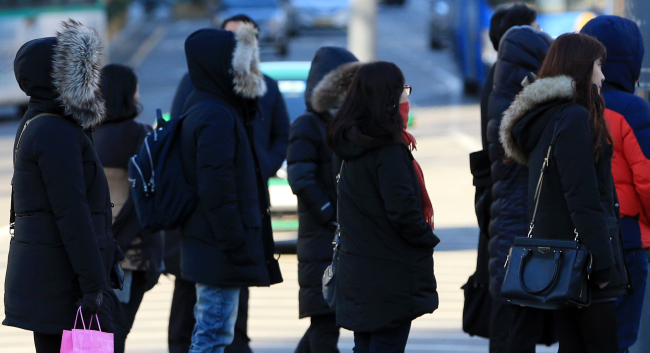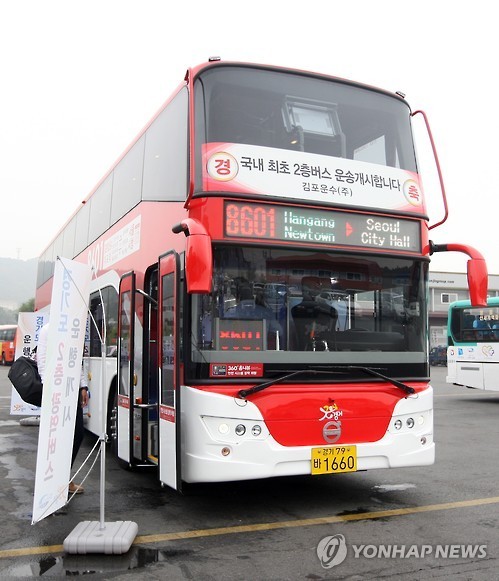Korea aims to ease commutes with more double-decker buses
By Kim Da-solPublished : April 20, 2016 - 16:43
At 6:50 a.m., a group of people with eyes half-closed make a long line outside Seoul Station.
“This is quite usual (to wait in a long line). Even if the bus is packed, I will still hop on and ride the bus standing for the entire 40 minutes,” said Jeong Hye-ryoung, who commutes to Pangyo in Gyeonggi Province for work every day.
Like Jeong, as many as 24,000 or 12.5 percent of bus commuters in the metropolitan region travel crammed into a bus daily, barely standing up and holding onto the seat for safety every morning. Gyeonggi Research Institute estimates an average bus commute to be over 61 minutes.
According to the Metropolitan Transportation Authority, there are 2,203 red buses -- which run between downtown Seoul and nearby suburban areas in Incheon and Gyeonggi Province -- on 166 bus routes.
“This is quite usual (to wait in a long line). Even if the bus is packed, I will still hop on and ride the bus standing for the entire 40 minutes,” said Jeong Hye-ryoung, who commutes to Pangyo in Gyeonggi Province for work every day.
Like Jeong, as many as 24,000 or 12.5 percent of bus commuters in the metropolitan region travel crammed into a bus daily, barely standing up and holding onto the seat for safety every morning. Gyeonggi Research Institute estimates an average bus commute to be over 61 minutes.
According to the Metropolitan Transportation Authority, there are 2,203 red buses -- which run between downtown Seoul and nearby suburban areas in Incheon and Gyeonggi Province -- on 166 bus routes.

In July 2014, the Transport Ministry banned standing in a traveling bus for safety reasons. But faced with protests from commuters, the ministry eased the restriction, instead promising to replace the packed single buses with double-decker buses as soon as possible.
Buses operated by Gyeonggi Province that travel to and from Seoul -- also called Mbuses -- are normally equipped with 39 to 41 seats. But double-decker buses can carry more passengers, with 79 seats.
South Korea’s first double-decker bus was introduced in December 2014, as part of a pilot operation by the Transport Ministry and the municipalities to alleviate road traffic.
There are nine double-decker buses running in Seoul so far, still far too few to dramatically ease the packed public transportation situation. Around 10 double-deckers will be added by August.
Buses operated by Gyeonggi Province that travel to and from Seoul -- also called Mbuses -- are normally equipped with 39 to 41 seats. But double-decker buses can carry more passengers, with 79 seats.
South Korea’s first double-decker bus was introduced in December 2014, as part of a pilot operation by the Transport Ministry and the municipalities to alleviate road traffic.
There are nine double-decker buses running in Seoul so far, still far too few to dramatically ease the packed public transportation situation. Around 10 double-deckers will be added by August.

“We are seeing that one double-decker bus is more efficient than two single-decker buses, since the operation costs of buying the buses and put them on the street is similar (whether single- or double-decker),” said Kwon Ho-jeong from the Transport Ministry’s public transportation division.
“Our ultimate goal is to replace old single-decker buses with double-decker buses, without having to increase the current rotation rate of buses,” he added.
The Gyeonggi Research Institute said that between October and March, the number of standing travelers in Namyangju and Gimpo in the province dropped by half after double-decker buses operated along those routes.
The plan, however, has encountered several problems, including the current restrictions against vehicle height and resistance from bus operators, who cite budget limitations.
Unlike those in Hong Kong or London, Korea’s road traffic law limits the maximum height of a bus to 4 meters.
When considering the total height of double-decker buses, the second floor of a bus in Korea needs to be built with a lower ceiling of 168 centimeters in height or less. This means it is more difficult for taller people to use the upper deck, not to mention the added cost of adjusting the height of buses that do not meet specifications, as is the case with many models. In Hong Kong, double-decker buses are built 4.1 to 4.4 meters tall.
The Transport Ministry explained that customizing the height of Korea’s double-decker buses is doable by getting them tailor-made or importing models that fit the standards set by the Automobile Management Act.
“But it could be problematic when it comes to setting the price at an appropriate level as there are certain costs and budgets set by each municipality and operators to introduce the double-decker buses,” said Kwon Ho-jeong of the ministry’s public transport division.
Some experts noted that flexibility may be needed to achieve the greater benefit of securing safety of commuters.
“The reason (the buses) cannot be over 4 meters tall is because of sign boards or displays on the road. It does not cost too much to adjust those, so why not be realistic?” said professor Kim Young-chan of traffic design from University of Seoul.
According to the industry insiders, local bus operators have also been reluctant to use double-decker buses due to purchasing and operation costs.
One double-decker bus costs about 450 million won ($392,000) -- with government funding of 300 million won putting the cost for bus operators at 150 million won.
But the operators are still not keen to buy them, citing existing financial difficulties.
An official at Gyeonggi Bus Workers’ Union, who wanted to be anonymous, claimed the numbers envisioned by the government were too vague.
“The amount of funding is not enough (to buy and operate the buses), as we are running at a deficit,” he said.
“(Regardless of our situation), the ministry will increase bus capacities for passengers, either by introducing longer buses (to 13 meter-long bus from current 11.5 meter-long buses) or higher buses with more seats.”
The Transport Ministry said it would not provide extra funding, but that it could consider arranging tax benefits.
There are also criticisms that the high cost of the double-decker plan is due to the high price of the bus model selected by the ministry. The buses are manufactured by Volvo and imported from Taiwan. The government said the model was the “most optimized” one with its safety verified in other countries.
Local double-decker buses made by companies such as Hyundai or Kia are priced at 150 million won ($130,000), only 30 percent of the price of imported versions. The ministry officials said the option of switching to local brands is still being reviewed.
By Kim Da-sol (ddd@heraldcorp.com)
“Our ultimate goal is to replace old single-decker buses with double-decker buses, without having to increase the current rotation rate of buses,” he added.
The Gyeonggi Research Institute said that between October and March, the number of standing travelers in Namyangju and Gimpo in the province dropped by half after double-decker buses operated along those routes.
The plan, however, has encountered several problems, including the current restrictions against vehicle height and resistance from bus operators, who cite budget limitations.
Unlike those in Hong Kong or London, Korea’s road traffic law limits the maximum height of a bus to 4 meters.
When considering the total height of double-decker buses, the second floor of a bus in Korea needs to be built with a lower ceiling of 168 centimeters in height or less. This means it is more difficult for taller people to use the upper deck, not to mention the added cost of adjusting the height of buses that do not meet specifications, as is the case with many models. In Hong Kong, double-decker buses are built 4.1 to 4.4 meters tall.
The Transport Ministry explained that customizing the height of Korea’s double-decker buses is doable by getting them tailor-made or importing models that fit the standards set by the Automobile Management Act.
“But it could be problematic when it comes to setting the price at an appropriate level as there are certain costs and budgets set by each municipality and operators to introduce the double-decker buses,” said Kwon Ho-jeong of the ministry’s public transport division.
Some experts noted that flexibility may be needed to achieve the greater benefit of securing safety of commuters.
“The reason (the buses) cannot be over 4 meters tall is because of sign boards or displays on the road. It does not cost too much to adjust those, so why not be realistic?” said professor Kim Young-chan of traffic design from University of Seoul.
According to the industry insiders, local bus operators have also been reluctant to use double-decker buses due to purchasing and operation costs.
One double-decker bus costs about 450 million won ($392,000) -- with government funding of 300 million won putting the cost for bus operators at 150 million won.
But the operators are still not keen to buy them, citing existing financial difficulties.
An official at Gyeonggi Bus Workers’ Union, who wanted to be anonymous, claimed the numbers envisioned by the government were too vague.
“The amount of funding is not enough (to buy and operate the buses), as we are running at a deficit,” he said.
“(Regardless of our situation), the ministry will increase bus capacities for passengers, either by introducing longer buses (to 13 meter-long bus from current 11.5 meter-long buses) or higher buses with more seats.”
The Transport Ministry said it would not provide extra funding, but that it could consider arranging tax benefits.
There are also criticisms that the high cost of the double-decker plan is due to the high price of the bus model selected by the ministry. The buses are manufactured by Volvo and imported from Taiwan. The government said the model was the “most optimized” one with its safety verified in other countries.
Local double-decker buses made by companies such as Hyundai or Kia are priced at 150 million won ($130,000), only 30 percent of the price of imported versions. The ministry officials said the option of switching to local brands is still being reviewed.
By Kim Da-sol (ddd@heraldcorp.com)



![[AtoZ into Korean mind] Humor in Korea: Navigating the line between what's funny and not](http://res.heraldm.com/phpwas/restmb_idxmake.php?idx=644&simg=/content/image/2024/04/22/20240422050642_0.jpg&u=)
![[Exclusive] Korean military set to ban iPhones over 'security' concerns](http://res.heraldm.com/phpwas/restmb_idxmake.php?idx=644&simg=/content/image/2024/04/23/20240423050599_0.jpg&u=20240423183955)



![[Graphic News] 77% of young Koreans still financially dependent](http://res.heraldm.com/phpwas/restmb_idxmake.php?idx=644&simg=/content/image/2024/04/22/20240422050762_0.gif&u=)
![[Herald Interview] Why Toss invited hackers to penetrate its system](http://res.heraldm.com/phpwas/restmb_idxmake.php?idx=644&simg=/content/image/2024/04/22/20240422050569_0.jpg&u=20240422150649)






![[Exclusive] Korean military to ban iPhones over security issues](http://res.heraldm.com/phpwas/restmb_idxmake.php?idx=652&simg=/content/image/2024/04/23/20240423050599_0.jpg&u=20240423183955)



![[Today’s K-pop] Ateez confirms US tour details](http://res.heraldm.com/phpwas/restmb_idxmake.php?idx=642&simg=/content/image/2024/04/23/20240423050700_0.jpg&u=)